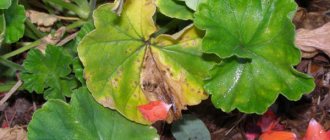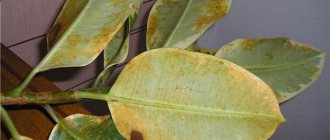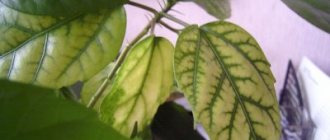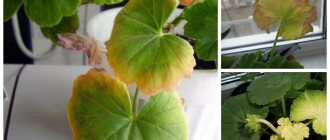If we talk about open ground, many gardeners notice that the leaves of roses turn yellow in the fall. This is primarily due to a drop in temperature. This is also affected by reduced daylight hours. But this only applies to the autumn period.
Author of the article
Eduard Dmitriev
Florist and lover of indoor and garden plants.
Pests
Sometimes the leaves of indoor roses slightly change color to a lighter shade, which many confuse with yellowness.
At the same time, the old leaf plates begin to wither, and the young ones grow deformed and pale. This indicates the presence of pests in the root system area. Carefully move the soil away from the base of the trunk and a little deeper. This is where harmful larvae or worms live. Some sources recommend catching parasites with tweezers. Give it a try. And it’s good if there was only one worm. What if the soil was more contaminated? Are you going to use tweezers all over the pot? During this time, the indoor rose will simply bend.
Don't rely on your sleight of hand, it may not be enough. Use any broad-spectrum or long-lasting systemic insecticide. Be sure to repeat the soil treatment in a month.
Advice. Be sure to replant your indoor rose from store-bought soil into your own. But only after disinfection by freezing or heating in the oven.
What to do to prevent recurrence of problems?
In order to prevent disease or death of roses, it is necessary to follow certain preventive measures. First of all, do not neglect compliance with the rules of agricultural technology. If the plant is affected by mold or pests, proper care will help reduce damage to the flower.
In flower shops, plants in pots are fertilized with special fertilizers that maintain their beautiful marketable appearance. Also, in the room where flowers are displayed, acceptable air humidity is constantly maintained. Therefore, getting from the favorable conditions of a flower shop to less favorable apartment conditions, an indoor rose may become less attractive, fade or get sick (what should be the care of a rose after purchasing it in a store?).
It is recommended not to allow negligence in care , even if the plant is in full health. Moreover, caring for an indoor rose is simple and does not require much time. Regularly pay attention to your plants and respond to symptoms of illness in a timely manner.
By following these simple tips and recommendations, you can help your indoor roses and extend their life. With proper care and sensitivity, this plant can delight you with its magnificent flowers for a long time.
Dangerous pests
Aphids, thrips and spider mites are the most common pests of house plants, due to which they often get sick and dry out. They are easy to spot. Usually both the insects themselves and traces of their activity are visible. The presence of parasites is indicated by gnawed areas of indoor rose leaves and small dark spots on them. The presence of a tick will be revealed by a spider web, which is usually located under the foliage. If such signs are found, it means that the flowers wither for this very reason.
All affected parts of the plant are carefully removed. Then treatment is carried out with special solutions against insects.
It is recommended to do this as a preventive measure in the summer, even if the pests are not visible.
Pests of indoor flowers
The depletion and wilting of indoor rose leaves may be associated with insect activity:
- spider mite. The insect drinks the sap of the plant, taking away nutrients. Because of this, small pale spots appear on the leaves. They grow and merge. Gradually, the entire leaf blade changes color, and the mite moves on, infecting the remaining parts of the rose. The insect weaves a web that is easily visible to the naked eye;
- thrips. A grayish coating appears on the leaves, their color becomes pale green, almost yellow. As a result, their shape changes and they become deformed. The spread of pests is facilitated by high temperatures and too dry air;
- rose leafhopper. Small insects are visible on the underside of the leaves; they are white or yellowish. The leafhopper first drinks the juices of the plant, and then begins to feed on its pulp. You can suspect their presence after detecting discolored dots on the leaf plates. Parasites carry viruses that can infect a rose. As a result, the growth of the flower stops, the leaves turn yellow and fall off.
Rose leafhopper
It is important to monitor watering, observe the temperature regime, and do not forget about feeding the plants, then the risk of pest damage is significantly reduced.
Note! If the leaves of an indoor rose turn yellow and then fall off, you need to carefully examine it for the presence of insects.
Causes of yellowing leaves of indoor roses
The reasons for yellowing of leaves can be very diverse, for example, sunburn. The fact is that direct sunlight is destructive, not only for the leaves of an indoor rose, but also for its flowers. It is best to keep this plant near windows that are directed to the southwest or southeast.
But there are several other possible reasons why the leaves of an indoor rose begin to turn yellow:
- watering the plant with too cold water;
- overdried substrate;
- draft;
- overflow
For normal functioning, indoor roses simply need fresh air. In this regard, in the summer it is best to keep it either on the balcony or on the terrace. You can also take a flowerpot with a rose to a flowerbed and bury it a little in the ground. If you live in an apartment and you don’t have this opportunity, you can keep the rose just next to an open window, while avoiding drafts. Thanks to such manipulations, an indoor rose can easily withstand even the strongest sun.
We present to your attention several possible reasons for the change in leaf color of indoor roses:
- if your indoor beauty does not have any pests and is not sick with anything, but its leaves still turn yellow, this may indicate that the plant lacks some nutrients;
- if the leaves of an indoor rose become pale green and turn yellow from the midrib, this directly indicates a lack of nitrogen;
- yellowed leaves with spots are evidence of potassium deficiency. And if yellowing is visible between the veins of the foliage, it means the plant lacks iron;
- Interestingly, rose leaves can turn yellow even if the plant receives too many nutrients. In order to prevent this, it is necessary to adhere to the correct dosage of fertilizer, which is indicated on the package;
- The plant should be fertilized on time, especially during the flowering period. The fact is that at this time the rose is greatly depleted and requires additional nutrition. If this is not done, the leaves of the plant will be yellow and limp, and the number of flowers will be insufficient;
- Another cause of yellow leaves may be chlorosis. The main signs of its presence are yellowing of the leaves, but with green veins, as well as yellow spots on green leaves. In order to combat this disease, as well as to prevent the disease, you should use a water-soluble iron chelate fertilizer. They need to not only water the plant, but also spray it.
Remember that another reason for yellowing of the leaves of an indoor rose may be its improper replanting. This plant must be replanted once a year, preferably in February
This is done by transshipment, but with extreme caution so as not to damage the roots of the plant in any way. An already transplanted plant should be moved to a warmer place.
By the way, when replanting a plant, it is necessary to change not only the soil, but also the pot. Every year its diameter should increase by 2-3 centimeters.
Improper care
A capricious rose cannot be ignored. You need to monitor the lighting, the temperature in the room, do not disturb the watering schedule and do not forget to feed the plant, otherwise the flower will lose its attractiveness and begin to hurt.
Lack of lighting
The indoor rose does not like direct sunlight and feels good in the fresh air. Therefore, in summer it is better to place it on the balcony or take it out into the garden, but slightly shade it, especially if it is located on the south side. If the plant is constantly exposed to the sun, there is a risk that it will scorch the leaves, and this will lead to burns.
For your information! It is enough to receive natural light for 5 hours a day. If a flower is uncomfortable, this will affect the color of its leaves. Those in the shade will begin to turn yellow. You can get rid of this by periodically turning the pot so that the sun illuminates the rose from all sides.
Bad soil
The soil for a rose must first of all be loose and allow water and moisture to pass through. The liquid must not stagnate at the roots. It is recommended to mix turf and humus in equal proportions and add a little sand. There are ready-made mixtures sold in stores.
Important! It is necessary to fill the bottom of the pot with drainage; a layer 1 s high is sufficient.
m.
Eating disorder
To keep the flower healthy, it needs to be fed periodically:
- if the rose lacks nitrogen, the leaves become pale and yellowish veins appear on them;
- lack of potassium also affects the appearance of the plant. Yellow spots form on the leaf blades.
If a rose does not receive enough fertilizer, its growth slows down and its attractiveness disappears. As a result, flowering becomes less colorful, leaves lose their brightness and juiciness, turn yellow, dry out and wither.
Leaves turn yellow and dry due to lack of fertilizers
Room temperature
The health of the rose is influenced not by the temperature in the room, but by the condition of the soil. Therefore, it is recommended to ensure that the flower pot does not heat up. In summer, it is better to move it to the balcony, but not to place it next to an open window or vent. In winter, the plant feels comfortable at room temperature.
Important! It is necessary to protect the flower from cold winds and sudden temperature changes during the day.
Drafts
Drafts are a danger to any indoor plant, not just roses. But fresh air must reach the flower. To create comfortable conditions for a capricious representative of the flora without harming it, you can make a cylinder of thick paper and wrap it around the pot. Otherwise, gardeners will experience yellowed leaves, which the plant will soon begin to shed.
Diseases that cause yellowing of roses
One of the common diseases of indoor roses is powdery mildew. Leaves, stems and buds are affected by fungi. First, a light fluffy coating appears, then it begins to darken, and brown spots form. The leaves turn yellow, become deformed, and curl. If you do not immediately react and treat the plant, it will die. At best, its growth will stop, the foliage will fall off, and the flowers will lose their petals. The rose will lose its attractive appearance.
All affected parts of the plant will have to be removed, otherwise it will not be possible to defeat the disease. It spreads rapidly and also easily spreads to neighboring flowers. Spores are carried on the hands after working with an injured representative of the flora, and easily move through the air.
Note! At the early stage of the disease, when the leaves seem to be sprinkled with flour, and the plaque is wiped off with your fingers, you can use a solution of soda with added soap. If the plant does not recover, it is better to resort to fungicides
Black spots may appear on the leaves of indoor roses. They have jagged edges and are clearly visible. At the same time, the leaf blades themselves turn pale, turn yellow, and wither. Over time, the spots grow and merge, and may appear on shoots. Plant growth slows down and flowering does not occur. The affected leaves fall off, new shoots are formed, which do not have time to gain strength and immediately encounter the disease. A systemic fungicide will help cope with it. The substance penetrates the plant and promotes its recovery.
If yellow-red spots are noticeable on the rose, then rust has appeared. The main reasons are high temperature at home and stale air when the room is rarely ventilated.
Rust appears due to stuffiness
Diseases and pests
Rose is a delicate plant, so it is susceptible to various diseases. This is, for example, powdery mildew, the symptoms of which are loss of color and falling leaves. If the climate in the room is incorrect, the crop may be affected by fungus.
Parasites can also damage roses. One of them is spider mites, which requires regular treatment to combat. Often the leaves begin to wither and fade if larvae have appeared in the root system. Since they multiply quickly and can destroy the plant, an insecticide has to be used. After a month, re-treatment is carried out.
Improper watering
If you water your flowers incorrectly, you can seriously harm them. Cold water should not be used to water roses. As a result, the bush becomes sick, stops growing and dies over time. The water should be soft and settled. Some gardeners advise boiling it.
The frequency of watering can be selected according to the condition of the soil in the pot. If its top layer begins to crack, moisturizing is necessary. Mature plants are watered two or three times a week. In the summer heat, you can water them more often and install a humidifier in the room.
The foliage of indoor roses often turns yellow due to improper watering of the plant. This can be either overwatering or insufficient watering. Overdrying of the flower, in addition to its yellowing and loss of leaves, may also be indicated by a general depressed appearance and the appearance of cracks in the soil. If overwatering occurs, the symptoms will be somewhat different: yellowing of the foliage in this case is accompanied by lethargy of the plant, its wilting, and the presence of a “swamp” in the pot.
What else affects the yellowing of leaves?
What does improper watering mean? It is strictly forbidden to water the rose garden with ice or even cold water. It is advisable that it is not hard - if possible, collect rainwater. You need to water the rose as the soil dries out; in hot weather, increase the amount of watering. The best time to water on sunny days is in the morning while the sun is low or in the evening after sunset. If you water in hot weather, the water that gets on the leaves will cause burns and brown spots.
Another reason why a rose loses its foliage color is also related to watering. But this time it's unnecessary. You should inspect the soil; if it is constantly wet, the flower is “flooded”. In constant dampness, yellowing and rotting of the green parts of the flower are inevitable. The same thing will happen with a lack of moisture. You cannot overdry the soil - to prevent the formation of a dry crust, it must be “diluted” with sawdust, small expanded clay and, of course, loosened.
The rose is sun-loving, so a lack of lighting will also manifest itself as yellowing of the leaves. It is advisable to transplant it to a sunnier place, or regularly trim the lower part of the rose bush. This will provide more sunlight to the plant. If you plan to plant the rose in a shady place, you can select shade-loving varieties.
Excessive foliage density can also spoil the color - the plant needs frequent pruning. Yes, and it is better to plant bushes away from each other.
Rose is royalty among the flower family. It is quite capricious, but with proper care it will bloom luxuriantly and delight with green foliage. Practical advice and a detailed description of the causes of the “illness” will help prevent it from turning yellow.
Why do rose leaves turn yellow?
Most often, yellowing of foliage is caused by the following reasons:
- Lack of mineral fertilizers. Depending on what the plant lacks, it turns yellow in different ways. When a crop needs nitrogen feeding, it turns yellow completely, starting from the lower leaves. Application of universal fertilizers or urea can help. If a rose lacks iron, it begins to turn yellow in spots - from top to bottom. In this case, any acidifying fertilizer will do.
- Excess feeding. Excess mineral fertilizers can also lead to leaf fall. When the flower is weakened and you want to feed it, it is better to start with half the dose, otherwise you can burn the roots.
- Pests and diseases. One of the most common diseases is chlorosis. You can fight it with the help of Antichlorosin, which dissolves well in water. The plant is watered with it twice during the growth period, and then once every two weeks, if necessary.
- Excessive humidity. Although roses love moisture, excess is harmful to it, otherwise it will begin not only to turn yellow, but also to rot. Finding a middle ground is not difficult - it is enough to provide good drainage and water the plant as soon as the top layer begins to dry out. In addition, it is useful to spray it with warm water from a spray bottle.
Other pests that cause yellowing and leaf drop
There are other pests that cause the leaves of this species to turn yellow:
- Common thrips. The appearance of this insect occurs when the temperature in the room is not observed. As temperatures rise and humidity levels drop, a silvery coating appears on the leaves, causing the flower to appear yellowed. In order to get rid of it, it is urgent to treat the entire pot and everything around with an insecticidal agent. It is better to do this using a fine spray bottle.
- Hot climates also favor the appearance of cicadas. The rose subspecies of this pest most often lives on indoor roses. If white spots appear on the leaves, then it is urgent to make a soap solution and treat the flower with it. When the foliage begins to fall off, the only way to save the rose is with the help of insecticides.
- Many insects are capable of “eating” the root system of an indoor rose. If the roots are damaged, they begin to dry out, and over time, all the leaves may fall off. All new leaves are deformed. The flower can completely wither if the rose is not systematically treated. Fitosporin is perfect for these purposes. Spraying and watering should be carried out 2 times a month.
On a note! Falling foliage can be caused by the rose's natural efforts. If the flower sheds its lower leaves, then perhaps there is no need to worry. But if the abscission is widespread, it is necessary to urgently begin treatment.
What to do if your houseplant drops its leaves?
There are several reasons why this whimsical plant sheds its leaves and dries up:
- Physiological aging is when a flower, at the final stage of its life, begins to shed its leaves and buds.
- Seasonality - when an indoor flower sheds its leaves in the fall so that new ones grow in the spring.
- Violation of the light regime - lack or excess of sunlight.
- A change in weather or a change in the microclimate of the house - a change in air temperature and humidity level in the room, the appearance of a draft or the start of heating devices in the house affect the condition of the rose.
- Violation of the irrigation regime - lack or excess of moisture in the soil.
- Presence of pests – parasites dangerous to flowers, especially spider mites, can destroy a plant in a matter of days.
- Unsuitable soil - a lack or excess of nutrients in the soil leads to the fact that the flower begins to hurt and wither.
- The rose is damaged by pathogenic microflora - the flower begins to rot or black spots appear on it.
- Carefully examine the flower. If the leaves turn yellow and fall off on one side, this may indicate an excess of sunlight. In such a situation, it is necessary to provide the rose with diffused light.
- Check the soil in the pot. If the pot has cracked, dry soil, you need to start watering it regularly. For irrigation, use pre-settled water at room temperature.
- Remember the last time the soil of the rose was changed. If it was more than a year ago, then it is advisable to urgently start feeding the plant. But you should carefully study the instructions and strictly follow them so as not to overfeed.
- Check leaves and stems. If pests are detected, it is recommended not to delay the start of treatment. In this case it is necessary:
- Isolate the rose from other plants.
- Use a sterile blade to trim off all affected areas.
- Treat with parasite repellent according to instructions.
If a rose drops all its leaves in the shortest possible time in spring or summer, this means that:
- The flower is located in a room with very dry air. What to do in a situation if the plant has dropped all its leaves:
- Move it to another room or install a humidifier nearby.
- Water the flower regularly and do not allow the soil to dry out.
The flower was infected with a dangerous disease. In this situation, the action plan is as follows:
- Trim off all affected areas of the flower and remaining buds with a sterile blade.
- Treat the plant with special means.
A rose that has dropped all its leaves will take a long time to recover, so it is recommended to be patient and wait, while observing the light and watering regime.
Why do roses in a pot dry out: reasons
The culprits of the poor health of potted roses, as a rule, are mistakes made when caring for them. To prevent the death of plants, in each specific case it is necessary to find out the cause of their ailment.
An indoor rose in a pot most often dries out due to:
- Low level of air humidity in the room.
- Proximity of heating devices.
- Improper organization of watering. Frequent watering or using too cold water can cause root rot.
- Serious damage to the root system, preventing the flow of nutrients to the plant.
- Exposure to cold air (if the plant pot is in a draft).
- Acute lack of microelements and nutrients in the substrate (nitrogen, potassium, iron, etc.).
- Pest attacks.
- High density soil in the pot, which creates an obstacle to the normal supply of oxygen to the roots.
- Insufficient lighting.
- Spraying too often (some varieties of roses react to this by yellowing and falling leaves).
Intense leaf fall is also observed during the period when the plant begins to prepare for wintering.
How to save an indoor rose after purchase
The rose is a difficult flower to keep at home; it is quite demanding and capricious. It is not enough to become the happy owner of this beauty, you also need to preserve the flower and find an approach to it, otherwise sad consequences will not keep you waiting.
Yes exactly. The purchased plant usually looks fresh and full of vigor, blooms amazingly and it seems that it will always be like that.
In fact, the plants arrive on the counter fed with all kinds of stimulants; in addition, they have special packaging that retains high humidity. Once on our windowsill, roses are deprived of all this.
Almost immediately, inexperienced gardeners have problems: the roses begin to turn yellow, their leaves dry out and fly off, the buds fall off and turn black. Rosette orders to live long and disappears, leaving behind nothing but frustration.
It should be noted that the rose is considered an open ground plant. Some varieties are more suitable for indoor use than others. But this does not mean that keeping them in an apartment is an easy matter.
So, what steps should you take when you bring a rose home:
Remove the packaging wrapper, if any. Although the packaging helps to retain moisture, it often causes the rose to become infected with fungal diseases while still in the store, because... packaging interferes with air exchange, creating an ideal environment for fungi. Use pruning shears or scissors to remove all wilted leaves, blackened and dried stems that are on the plant. Flowers and buds also need to be trimmed. Of course, for the sake of them we buy a plant and we would like to admire them to our heart’s content, but the plant, the flowering of which was stimulated by special preparations and greenhouse care, subsequently simply cannot withstand such abundant flowering, and, having given all its strength to it, dies
Therefore, we cut off all the flowers and buds that are present on the plant, along with the supporting stem. Pay attention to the number of bushes in the pot. Growers of indoor roses often plant several plants in one pot to create the appearance of a lush flowering bush.
Crowded plants weaken each other and there is a lack of nutrients. Bushes, if there are several of them, must be planted in different pots.
After transplantation, it is necessary to treat the rose with antifungal drugs (Fitosporin) and pest control drugs (Fitoverm).
Inherent diseases and pests
If the care and soil are chosen correctly, the leaves of an indoor rose may still turn yellow. An inexperienced flower lover may confuse aging with illness. As they age, the lower leaves begin to die off and their number decreases.
The appearance of black spots is a signal of a disease; traditional methods rarely cope with it. Fungicides are a real salvation from this scourge. It must be diluted according to the instructions and sprayed from a spray bottle for several days. If the cause of the blackening was caused by bacteria, this treatment will certainly help.
If the leaves become whitish in color, and new ones grow curled and limp, then the cause should be sought in the root system. This is where parasites can settle. You won't be able to remove them with tweezers or your hands. Spider mites can settle on the plant; this can be determined by the presence of white dots. It usually occurs when the air is dry and there is a lack of watering. Another pest is tripe; the leaves turn yellow with a gray coating. Treating the soil with an insecticide or phytoverm will help. The procedure should be repeated after a month.
Caring for an indoor rose after purchase - how to preserve a flower
The indoor rose is a very delicate flower and capricious to environmental conditions, so you should take care of this beauty from the first days of its acquisition. The fact is that in flower shops, roses in pots are fed with special preparations, thanks to which they maintain their ideal appearance; in addition, the packaging of the plant helps maintain the required humidity level.
- Remove the cellophane packaging - in apartment conditions it will not maintain the required level of humidity, but will cause poor air circulation and the appearance of pathogenic bacteria and fungus;
- Cut off all non-living leaves and stems with sharp scissors; the same should be done with leaves that have defects - spots, dried tips;
- Remove flowers and growing buds, no matter how sorry it is - if you give all the emerging buds the opportunity to bloom, the rose will lose all its strength and die;
- Plant a rose if several bushes are planted in one small pot (as a rule, in stores they do this to give the flower a lush shape) - this way there will be enough nutrients in the soil for each bush;
- Treat your home rose with drugs against fungus and parasites (Fitosporin, Fitoverm).
Replanting an indoor rose after purchase is necessary if the pot is too small for it - in this case, the flower is carefully removed from the old flower garden along with the soil, the brown and black roots are removed (the healthy color of rose roots is white), rotten parts, then the plant is placed in a new pot with properly selected soil. The soil for roses can be prepared independently; for this you will need:
- Compost;
- Leaf humus;
- Soil from under coniferous trees;
- Turf soil;
- Clean sand.
The listed components are mixed in a ratio of 1:1:1:3:1, the soil mixture is poured into the flower garden on top of the drainage. The rose is placed in a new pot along with an old lump of earth, firmly fixed and watered with warm water. It is recommended to treat the newly transplanted plant with a drug to enhance immunity - Epin is ideal.
Infectious diseases
In addition to fungi, rose bushes can be affected by infectious diseases - bacterial cancer. It manifests itself as redness and thickening of the stems and roots, and round spots also appear.
After the leaves and stems die off, this type of infection lives in the ground for several more years. In this regard, you should get rid of such soil so as not to infect the next plants that will be planted in this pot. After removing such soil, the pot must be disinfected and, if possible, boiled for several minutes.
There is also a disease called indoor rose jaundice. The carriers of this disease are insects. Diseased leaves become yellowish, gradually wither, and if the spread of this disease is not prevented, it will lead to a disastrous outcome.
Weak areas of the bush should be cut off and burned. If the flower itself is severely damaged by this, and there is no way to revive it, then it is also necessary to burn it so that the infection does not enter the soil and infect other plantings, even if they grow outside.
Roses are susceptible to infectious burns. The leaves begin to dry out from the center, gradually becoming completely brown in color, with pink edging. These areas spread quickly in rooms where there is not enough oxygen, i.e. poorly ventilated. If you don’t miss the moment, the flower can be saved by cutting off only the affected leaves.
Powdery mildew is the second most common disease of indoor roses after spider mites. The white color of the leaves immediately signals a disease. It develops instantly and leads to the death of the flower.
Having noticed an infection, there is no need to hesitate; it is important to immediately begin cutting off the infected leaves and buds. If the disease has affected more than half of the plant, then it is necessary to cut off the bush, leaving shoots 5 cm above the ground. Be sure to follow it with spraying with a special solution purchased at a flower shop.
Pests and feeding
Rose, like many other indoor plants, is very afraid of spider mites. Determining the presence of such a pest is quite simple. The leaves begin to fall and small bugs can be seen climbing on them. If you turn the leaf over, you can see a characteristic white coating on its back side. To solve this problem, you need to use special preparations that are sold in flower shops. Spraying the flowerpot is carried out according to the instructions on the product packaging.
Roses are quite capricious and demanding plants. For normal flowerpot growth you will need a sufficient amount of minerals and trace elements. A lack of any element will negatively affect the plant. So, if a flower lacks magnesium, its leaves begin to fall off over time. In the case of a lack of nitrogen, they stop growing and change their color. To prevent such changes, it is necessary to feed the plant in a timely manner. To do this, it is worth using special fertilizers designed specifically for flowering flowerpots.
A common cause of discoloration and falling leaves is excessive flowering. The development of buds and flowering takes quite a lot of effort. When there is a lot of color, the leaves become defenseless and are easily susceptible to diseases, pests and various changes. This problem is solved with the help of special fertilizers and preparations that are sprayed on the flowerpot. With their help, you can strengthen the flower’s immunity and supply it with all the microelements and minerals for full growth and development. All medications must be used in accordance with the instructions.
The rose leaves turn yellow and fall off
The indoor rose is a capricious and whimsical plant that will have to pay a lot of attention. Miniature and hybrid tea varieties are usually grown at home. In open ground they are not so picky.
Rose is very capricious and picky
For your information! Varieties descended from tea roses are distinguished by a pleasant aroma, reminiscent of a tonic drink, to which they owe their name.
If a flower is uncomfortable at home, it will react instantly: its leaves will turn yellow, begin to curl and fall off. The health of a rose depends on many factors, primarily on the position in the house, whether the plant has enough light, and whether it is not affected by drafts. The quality of the soil plays an important role. If the flower does not receive enough minerals, this will affect its appearance.
The Chinese rose is considered less capricious; with proper care, after a few years it turns into a real tree. It survives both in cool and hot conditions, and can exist in the shade. It is also called hibiscus or Chinese rose.
A healthy plant blooms regularly, its leaf blades are green, without damage or spots. They are smooth and not deformed. The appearance of plaque, inclusions of various shades from white to black, indicates infection of the plant. Diseases and parasites deprive the rose of its strength and undermine its immunity. It stops growing, flowering, if it happens, is short-lived and not colorful. The shade of the leaves changes, they fade, turn yellow, begin to dry out and fall off.
Yellowing of roses due to lack of nutrients in the soil
The beginning of yellowing or falling leaves can be explained by a lack of useful elements in the soil. The most important substances that influence the development of culture include the following:
Iron
Why do rose leaves turn yellow outside in summer?
A deficiency of this substance provokes the development of chlorosis. With this disease, the foliage becomes yellow, decreases in size and curls.
To cope with the problem, it is worth using products such as Ferrilene, Ferovit. The ampoule of the composition must be mixed with water and sprinkled on the plants.
Nitrogen
This product is responsible for the condition of the green mass. A deficiency of the element provokes blanching of the foliage and its gradual yellowing.
Roses have a special need for the element in the spring. In this case, you need to add ammonium nitrate. It is also permissible to use a combined composition.
For reference! It is worth considering that excess nitrogen can cause fungal pathologies, which negatively affects the condition of the bushes.
Potassium
If there is a lack of this element, the edges of the leaves dry out in the plant. At the same time, the veins remain green. After a certain time, the leaf blades turn completely yellow and turn red-violet.
The rose should be fed with potassium magnesia. A large amount of potassium provokes developmental delays.
Manganese
Affected foliage acquires a yellow tint between the veins - from the edges to the central part. A green border appears around the veins. In this case, only old leaves turn yellow. The rose needs to be fertilized with manganese sulfate and the soil deoxidized. You can add peat to it. Ammonium sulfate will also work.
Magnesium
If there is not enough of this substance, dark red spots appear between the veins. The edges of the leaves remain green. At the same time, they are observed to fall off.
To avoid such problems, you need to regularly add ash to the soil. Magnesium sulfate will also work. In this case, the increased content of the substance provokes a violation of the absorption of potassium.
Insufficient application of fertilizers provokes the appearance of a yellow border on the foliage.
Current questions about yellowing of rose leaves
Question No. 1. How to deal with yellowing leaves of roses in a greenhouse?
The reasons for yellowing of roses in greenhouses and conservatories are the same as for outdoor plants. A control plan must be developed by first finding out why this condition arose. Sometimes in greenhouses yellow spots on roses can appear due to sunburn. In this case, it is necessary to take care of shading - for example, using a special mesh.
Question No. 3. What to do if your indoor rose turns yellow?
First, establish the cause. Indoor roses most often turn yellow due to lack of light or nutrition. It is better to keep them on racks equipped with phytolamps, since the illumination of window sills is usually insufficient, especially in autumn and winter. The duration of daylight should be at least 16 hours.
It is also important to regulate watering. The need for watering is determined by soil moisture at a depth of 2 cm
This is easy to do with a wooden skewer. If it remains dry and clean after immersion in the ground, the rose needs to be watered.
Question No. 4. Is there any point in leaving yellowed leaves on a rose?
Yellowing of leaves is an irreversible process. It occurs due to the destruction of chlorophyll. At the same time, metabolites accumulate in the leaf tissues, which lead to its death. Once a leaf turns yellow, it will no longer turn green, so there is no point in leaving it on the bush. And if the yellowing was caused by a disease, it can even be dangerous - the infection will spread further throughout the plant. Based on this, yellow leaves from the bush need to be removed.
Question No. 5. Can a rose turn yellow due to a sudden change in weather from warm to cold?
Modern varieties and hybrids of roses usually show high resistance to unfavorable climatic factors. However, a sharp cold snap can indeed cause yellowing of the leaves. Therefore, in extreme summers with unstable weather, it is advisable to keep non-woven covering material on hand. If the weather forecast promises sharp temperature fluctuations, you can wrap the bushes in it for a while.
Rate the quality of the article
Your opinion is important to us:
Detrimental factors affecting flower development
First you need to figure out why the leaves of an indoor rose turn yellow. Often, to solve this problem, it is enough to move the pot to another place where there is no direct exposure to sunlight - then the condition of the flower will normalize. But it happens that the reasons for yellowing of leaves lie in other unfavorable conditions for the development of the plant.
Unfavorable factors for roses
If you water with too cold water, you should water with water at room temperature. Drafts - it is recommended not to keep the plant under an open window. Abundant or, on the contrary, rare watering - the rose requires optimal moisture content in the soil. Lack of fresh air - in summer you need to take the pot out onto the balcony or terrace. Lack of nutrients - roses definitely require regular feeding. Incorrect replanting - if you need to move the plant into a large container, this should be done with the utmost care, and the month chosen for such actions is February. In this case, the rose has a better chance of taking root. Powdery mildew is a white coating that appears when there is excessive application of fertilizers or lack of fresh air. Rust – appears in the form of bumps
The reasons for its appearance are abundant watering and high room temperature. Thrips - appears at low humidity, it gives the leaves a gray-yellow color. Spider mites are caused by too dry air or insufficient space for plants.
Factors that prevent a flower from developing
Why do the leaves of indoor roses turn yellow and cobwebs appear?
Indoor roses require sufficient moisture. In the hot season, if the flower is in the room, it needs to be sprayed twice a day. If the plant is in a cool place, for example, on a loggia, and rainy days prevail, it is better to refuse additional moisture.
Roses feel great on the loggia
Note! It is important to take care of lighting, soil for the plant and timely watering. Cold water should not be used. It should be at room temperature, it is advisable to prepare it in advance so that it can settle.
Roses need nutrients from fertilizers. A lack or excess of various elements affects the health of the plant.
A rose can get sick after an incorrect transplant:
- You cannot choose a pot that is too large. The new container should be a couple of centimeters larger than the previous one;
- It is recommended to replant the plant in late winter or early spring. At this time, there is a high chance that the rose will take root without problems;
- It is better to use a ceramic container. The soil in such a pot will not heat up in the sun, which means the rose will be comfortable;
- After the procedure, you need to place the flower in a dark place where the temperature will not exceed 20 ° C. After two days you can put the pot in its permanent place.
The plant may encounter various diseases; roses are usually affected by fungi. Flowers are also attacked by pests that destroy the nutrients necessary for growth. As a result, the appearance deteriorates, the rose stops developing and may die.
Transplanting an indoor rose
To replant a rose, remove it from the previous pot along with the earthen lump. Assess the condition of the roots entwined in the ground.
If the roots are hair-thin, brown or blackened, dry or rotten, the plant will most likely die. You can try to save it: cut cuttings and try to root them.
Healthy roots are bright white or yellowish in color and look quite dense, like a thin wire. If the roots are only partially missing, you need to remove all the rotten and damaged ones, leaving the healthy ones.
Place expanded clay or other drainage at the bottom of the new pot.
It is better to purchase a soil mixture ready for roses or a garden mixture. Do not use cheap soil; it contains a lot of peat and few nutrients. It is better to choose a higher quality soil mixture.
Fill the drainage with soil and compact it a little. Place the rose bush together with a lump of earth, cover it with new soil, periodically compacting it so that the bush does not dangle in the pot, but is well fixed. Water with settled or filtered water at room temperature.
Treatment against diseases and pests is necessary. A pruned and replanted plant is weakened and susceptible to disease, even if it was well cared for at the store and no infection occurred. Therefore, it is better to play it safe and process it.
Also, after transplantation, treatment with Epin is effective - it will strengthen the plant’s immunity and reduce stress from transplantation.
Spray your plant; it requires high humidity, especially in conditions of operating heating and dry air in the apartment. If the rose is very small and weak, then the pot can be covered with a bottle (with small holes) on top, creating a greenhouse, and only then gradually accustom the rose to apartment air.
Next, we place the pot with the transplanted plant in a well-lit place. If you have a shady side and there is not enough light in winter, illuminate the rose with fluorescent lamps.
Diseases and pests
Yellowing leaves may be a reaction to disease. If the disease is caused by a fungus, the bush can be easily saved. If the causative agent is a virus, then the infected individual must be eliminated from the site and destroyed.
Roses are most often attacked by black spot. Sometimes it is not even considered a disease, believing that the spots are a natural development of the plant. However, this is still a fungal disease that is dangerous for almost all varieties of roses.
A fallen leaf from a bush is evidence that the plant will not survive the winter well and will slow down its growth and flowering.
Yellow leaves with black spots are a manifestation of spotting. You can help the crop with complex fungicides, for example, Topaz, but it is more effective to use such sprays for prevention (mid-to-late June).
In addition, there are viral diseases, as a result of which the leaves become covered with small or large spots of various colors. Usually the leaves become smaller, change shape, and the plant itself slows down and stops blooming. There are no methods for treating viral plant diseases, so infected bushes are simply removed from the site and destroyed.
If the leaves not only turn yellow, but also begin to fade, then there is a high probability that the larvae of the May beetle or other rootworms have settled on the roots of the flowers. Pests can be controlled with a variety of insecticides.
So, rose growers often observe yellowing of the leaves of their plants. Some cannot determine the cause of the phenomenon, while others do not know what to do to change the situation. Leaves from roses can turn yellow and fall for various reasons. But they are easy to identify and subsequently eliminate. The main thing is to carefully monitor the flowers and not take yellowing for granted, the natural development of individuals.
The indoor rose sheds its leaves and buds and dries up. Why does this happen and how to save the plant?
Falling leaves of an indoor rose is a sign of improper care of the plant. Since this royal flower is very capricious, even experienced gardeners, when this problem arises, cannot always understand the first time where the mistake was made.
But if you don’t help the flower in time, it will soon die. Later in the article we will tell you when it is normal for a rose to lose its leaves, and in what cases you need to sound the alarm.
When is it natural and when is it not?
If in the fall or after the end of the growing season, the leaves and faded buds of an indoor rose gradually begin to dry out and fall off, then there is no reason to panic - this is a natural physiological process.
This process is necessary for the renewal of the rose and its transition to the dormant stage. Unnatural abscission is considered:
- Loss of leaves in spring and summer.
- Yellowing and falling leaves on only one side of the flower.
- The appearance of black spots, red veins, and white coating on the leaves.
If such a situation arises, it is necessary to help the flower as soon as possible.
General rules for caring for roses at home
When growing roses at home, you need to consider the following nuances:
Humidity and temperature
Roses require relatively cool temperatures in winter and moderate temperatures in summer. For plants, it is not so much dangerous to increase it as to overheat the soil in the pot. The optimal temperature for roses in summer is up to 25°C. At the same time, insignificant daily fluctuations in this indicator will benefit the plants. In winter, plants are moved to rooms with a temperature within 15°C.
Roses
For roses, humidified air is preferable. In excessively dry conditions, plants are severely affected by parasites. In connection with this, plants in warm conditions require a single light spray every 2 days, after which they must dry out.
Note! To get rid of dust on the surface of the foliage, plants are given a short warm shower from time to time.
Soil and pot
The shape of the container is not significant for roses. The pot should only be large enough so that the plants can fully develop and the air can circulate normally. As the roses grow, they are transplanted into other pots with a larger volume.
In decorative terms, plastic ones are the most attractive, but the soil in them dries quickly, causing the buds to wither. Clay pots are also not recommended for use, since moisture drains quickly from them.
The soil for roses at home should be moisture-permeable and breathable. It should include the following components:
- 4 parts humus;
- 1 part each of sand and turf soil.
The pot should be equipped with a high-quality drainage system that will allow excess liquid to easily flow through the soil. However, the holes should not be too large to prevent water from pouring out too quickly.
Light
On a note! Like the vast majority of ornamental plants, roses respond positively to good lighting. However, an excess of sun light provokes overheating of plants. To prevent this, pots with plants are usually placed on window sills on the west or southeast side.
In summer, if possible, containers with flowers are taken out onto the terrace or balcony, where fresh air is available to them. This is necessary to prevent direct sunlight from hitting the foliage. If this is not possible, you should move the pot to another window sill or shade it.
Why does it drop buds and how to help a plant in a pot?
Reasons why indoor roses drop buds:
- Cold or draft in the room.
- Use for cold water irrigation.
- Transplanting a rose when its buds have formed.
- Irregular watering.
- Depletion of soil in the pot.
- Excess fertilizer.
- Sudden changes in air temperature and humidity levels.
- Plant damage by pests.
To help the plant you need:
- Check leaves and stems for pests. If they are detected, it is worth treating the plant as soon as possible.
- Analyze the plant care being carried out. Perhaps mistakes were made in the form of irregular watering, incorrect application of fertilizers, or violation of the light regime. Correcting these errors will help restore the plant.
- Place the rose in a warm, draft-free room.
- Water with settled water at room temperature.
Diseases and pests of roses
Fungal diseases can be treated, which cannot be said about a viral infection. With a viral infection, the plant is simply destroyed. The appearance of black spotting indicates that a rose is infected with a fungus. At the same time, the leaves also turn yellow. The disease depletes the bush, which will survive the winter cold worse and will grow and bloom poorly. This infection can be treated with a systemic fungicide. In order to prevent the disease, it is necessary to carry out preventive spraying starting in mid-June.
Rose leaves may turn yellow due to root canker. The lesion may occur at the site of the root collar or grafting. Cancer is a fungus that occurs in almost all soils. It affects the plant as a result of injury or shaking of branches in strong winds. As a result, they can prick branches that are nearby. Initially, the roots are affected. You may notice yellowish or brown spots on the shoots of the plant. As the disease spreads, they can deepen and lead to the death of the plant. On rose leaves, cancer appears as small purple spots.
You can save a rose by digging up the plant. You need to see if there are cancerous growths on the rose. If they are present, the growth must be removed. The root system should be treated with fungicides and the flower transplanted to another area. In the case when the rose is large and digging up the plant is problematic, you need to tear off all the damaged leaves. Shrubs can be treated with chemical or organic fungicides. With their help, the plant's immunity is well strengthened. Under their influence, the development of the cancer fungus is stopped. As a result, the defeat will not affect the bushes located nearby.
Spider mites cause yellowing of rose leaves. The red-colored insect is present on the underside of the leaf. They envelop the shoots with their web. Due to spider mite damage, the leaves turn yellow and dry out. The causes of infection may be another plant or dry air (this especially applies to indoor roses). An effective measure for exterminating the pest is considered to be spraying the plant with Fitoverm. You can also use “Akarin”, “Vermitek” and “Aktellik”. They can effectively destroy parasite eggs. Spraying must be done twice with an interval of ten days. Regular bathing of the plant is considered an excellent way to prevent pathology. The ground should be covered with polyethylene and the pot should be placed under running warm water.
The cicada reproduces at a particularly rapid rate when the temperature is elevated. She carries viral diseases. Damaged leaves need to be torn off. In this way, you can get rid of parasite eggs. The bush must be treated with insecticides
Increased attention needs to be paid to the underside of the leaves. Gardeners often recommend using “Fitoverm” and “Aktara”
The effectiveness of the drug increases significantly when adding a spoonful of alcohol to a liter of working solution. This facilitates the unhindered penetration of the substance through the insect’s shell.
Thrips can cause yellowing of rose leaves. Moving insects are quite difficult to see with the naked eye. They can easily fly to nearby flowers. This state of affairs could cause an entire epidemic. Thrips feed on plant sap. As a result, dark spots appear on the leaves, which is a consequence of their deformation. Rapid spread is caused by high temperatures and dry air.
After transplantation, the rose withers: what to do
Why do cucumber leaves dry out?
This unpleasant consequence of transplantation is most often observed if the wrong pot was selected. Before replanting, you should estimate the approximate dimensions of the root system and earthen ball and select a transplant container based on the data obtained.
Transplantation should be carried out with caution, paying special attention to the preservation of the root system. The slightest injury to it can provoke the death of the rose, which will be accompanied by drying out of the foliage. All other subtleties of the technology of transplanting and cultivating roses must also be observed.
Prevention
Disease prevention can be achieved by regularly maintaining optimal humidity levels. The plant can be treated with Actellik. Excessive dosage of the product must be diluted with anti-flea shampoo. Don’t forget to water the plant’s soil.
You can protect a plant from aphids if you plant it at some distance from each other. Between the bushes it is necessary to plant plants that repel aphids (lavender). When there are not very many aphids, the leaves can be torn off. In a situation where aphids infect the plant completely, you need to use special solutions.
For more information about the problem and how to fix it, see here:
Other common plant diseases and methods of treating them
We have already named some of the ailments above. We list the following common diseases characteristic of clerodendrum:
- Chlorosis. It appears as white spots on the leaves, gradually the entire plate turns pale. The preparations Ferrovit and Ferrilene are well suited. They are diluted for spraying or added to water for spraying. The dosage is indicated on the packaging.
- Root rot. Leads to the withering of all parts of the culture. You need to remove the plant from the pot, wash all the roots, inspect them, remove the affected parts, and sprinkle the cut areas with crushed coal (or ash). Wait until the rhizome is completely dry and plant the flower in new soil.
- Stem rot. Dark pigmentation appears on the shoots. Immediately remove all affected areas and treat healthy parts with a fungicide. Adjust the watering mode.
- Powdery mildew. A white coating appears on the leaves. Cut off all infected parts, treat the healthy part with a fungicide. Reduce the frequency and abundance of watering.
- Downy mildew. A plaque also appears, but this time it is covered with a light fluff. Control and prevention measures are the same as in the case of powdery mildew.
Clerodendrum is an original plant that will become one of the main flower plants in your collection. But to achieve an attractive appearance, it is necessary to provide the crop with proper care and timely control of diseases and pests.











